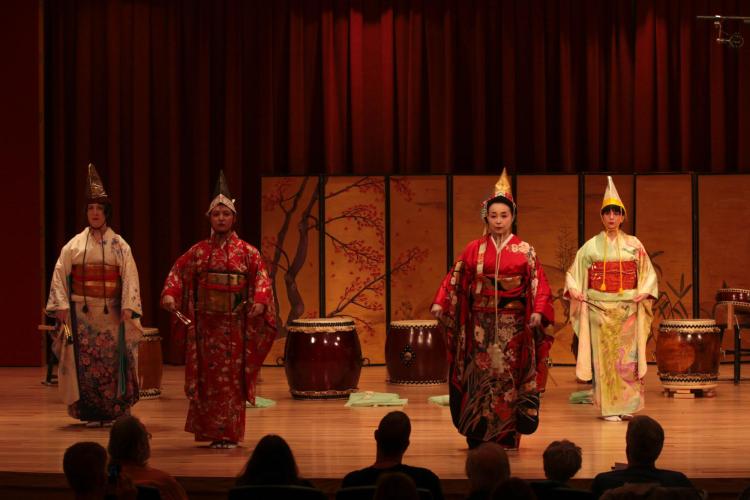World Music Showcase: The Japanese Ensemble

Students dressed in traditional Japanese robes perform at last spring’s Japanese Ensemble concert
Your chance to gaze through a window into a far-away culture is coming up next week in Grusin Music Hall.
Led by instructor Mami Itasaka-Keister, the Japanese Ensemble takes the stage in a flurry of colorful costumes and distinctive instruments on Sunday, Nov. 5. It’s one of several concerts put on by the College of Music’s World Music Ensembles during the month of November.
Ethnomusicology professor Jay Keister, who coordinates the World Music Ensembles, says the popularity of the Japanese Ensemble has been rising in the past few years as more people are exposed to Japanese popular culture.
“It’s exploded since the late 90s. When I came back to the U.S. after spending three years studying in Japan, I was surprised to see so many people here interested in the culture. The success of anime has been a big part of that.”
Anime will be a big part of next week’s concert as well: In addition to several traditional pieces, the program includes music from “Kamisama hajimemashita,” a television series that has built a following in the U.S. recently.
Another foot in the door for newcomers to traditional Japanese music will be the segment of the concert devoted to taiko drumming. The drums, which were introduced to the nation in the 6th century from nearby China and Korea, have been used by the Japanese everywhere from battlefields to houses of worship.
“That’s kind of what the Japanese do, culturally. They borrow things from other countries and transform them into things that can fit into their small island country,” Keister says.
Keister says the huge drums make for a thrilling opening to the concert, and a perfect entry instrument for students who are new to the ensemble.
“Not everyone in the ensemble is experienced, so they see stringed instruments or flutes and get intimidated by them. But if you put a stick in their hands, they can do that. They’re learning basic musical skills, and that’s very valuable.”
Another centerpiece of any Japanese Ensemble concert is the costumed dance presented by Mami Itasaka-Keister and the students in the group who have trained with her in the traditional Bando style of dance.
“It’s one of the oldest schools of classical Japanese dance, and Mami is a certified instructor. She teaches a few dancers privately, whom we invite to to perform with the ensemble.”
Keister says the holistic presentation of the Japanese culture is by design.
“We sing in Japanese, so we make an effort to translate things visually to explain what’s going on. World music, especially when you teach traditional forms, is not something that’s necessarily palatable to the average audience. We believe in programming that will communicate something to an audience.”
Keister says these glimpses into other musical traditions around the world are important for members of the audience and for students themselves.
“Many of the students in the World Music Ensemble classes haven’t traveled. These ensembles are a way to expose them to other cultures in a way they haven’t been before.
“It’s crucial to get that perspective in an academic setting. How we define music is often narrow, suggesting Western classical music. But things outside that realm have squeezed in, such as jazz, pop and world music. Expanding our scope of what music is is of primary importance.”
The Japanese Ensemble performs on Sunday, Nov. 5, at 2 p.m. in Grusin Music Hall. The concert is free and open to the public. To see other upcoming World Music Ensemble concerts, check cupresents.org.


